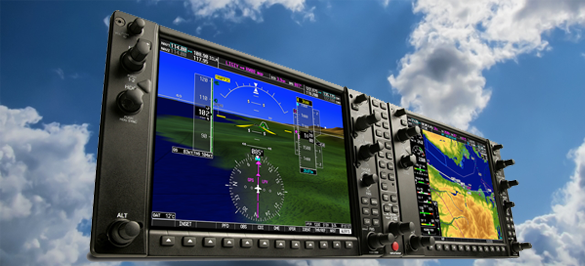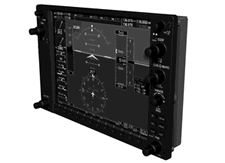GARMIN G900X INTEGRATED SYSTEM

- Descripción
- Características
- Condiciones de Instalacion
Garmin G900X

El Garmin G900X es una suite de última tecnología de Glass Cockpit. Con todos los elementos necesarios integrados en sus dos o tres magnificas pantallas de cristal liquido de alta resolución, hacen que el scan de nuestra información de vuelo sea rápido y eficaz, que comporta un nuevo estándar en lo que a seguridad, simplicidad y posionamiento se refiere.
El G900X incluye los siguientes elementos:
• GDU Display
• GMA Audio Panel
• GMC/GCU Remote Controllers
• GIA Integrated Avionics Unit
• GDC Air Data Computer
• GRS AHRS sistema de referencia de actitud y rumbo
• GMU magnetómetro tri-axial
• GTX Transponder
• GEA Engine/Airframe Unit
• GSD Data Aggregator
Si necesita instalar la visión sintética en su G900 no deje de solicitarnos información.
Si lo necesita, solicitemos información de como instalar Jeppesen ChartView en su G900.
La aeronave con una instalación básica consiste en dos displays. La pantalla situada en la posición del piloto actúa como display de vuelo primario (PFD) y la pantalla situada en la posición del copiloto como display multifunción (MFD) así como un panel de comunicaciones integrado, situado entre las dos pantallas.
En instalaciones mas sofisticadas del G900X se utiliza una tercera pantalla mas grande situada entre las dos, y en este dos pantallas actúan como display de vuelo primario (PFD) de Piloto y Copiloto.
Además incluyen:
* Un teclado alfanumérico
* Un flight director/autopilot integrado (sin el, un G900X conecta con un Autopilot externo)
Dependiendo de si la aeronave lleva un Autopilot GFC 700 instalado, el sistema G900X dispondrá de dos displays GDU 1040 (sin autopilot), un GDU 1040 PFD/GDU 1043 MFD (con un GFC 700 autopilot instalado), o un GDU 1045 PFD/GDU 1045 MFD (con un GFC 700 autopilot instalado con VNAV).
The GDU 1040 is the standard base bezel with no autopilot/flight director mode selection keys below the heading bug. The GDU 1043 has autopilot/flight director keys for all GFC 700 modes except VNAV. The GDU 1045 is essentially identical to the GDU 1043 except for the addition of an autopilot/flight director mode for VNAV. Depending on how the units are installed, an MFD failure may, or may not, have an impact on autopilot or flight director use. If a GDU 1040 is used as a PFD in an airplane equipped with a GFC 700 autopilot, a failure of the MFD (which houses the autopilot mode selection keys) will leave the autopilot engaged, but the modes cannot be changed because no autopilot keys are present on the PFD. But, if an MFD failure occurs in an airplane with the GFC 700 autopilot and either a GDU 1043 or a GDU 1045 bezel installed as a PFD, the pilot will have full use of the autopilot through the keys on the PFD.
Both the PFD and MFD each have two slots for SD memory cards. The top slot is used to update the Jeppesen aviation database every 28 days. The aviation database must be current to use GPS for navigation during IFR instrument approaches. The bottom slot houses the World terrain and Jeppesen obstacle databases. While terrain information rarely changes or needs to be updated, obstacle databases can be updated every 56 days through a subscription service. The top card can be removed from the G900X system following an update, but the bottom card must stay in both the PFD and MFD to ensure accurate terrain awareness and TAWS-B information.
Primary flight display (PFD)
The primary flight display shows the basic flight instruments, such as the airspeed indicator, the altimeter, the heading indicator, and course deviation indicator. A small map called the "inset map" can be enabled in the corner. The buttons on the PFD are used to set the squawk code on the transponder. The PFD can also be used for entering and activating flight plans. The PFD also has a "reversionary mode" which is capable of displaying all information shown on the MFD (for example, engine gauges and navigational information). This capability is provided in case of an MFD failure.
Multi-function display (MFD)
The MFD usually shows engine instrumentation and a moving map. The multi-function display typically shows a moving map on the right side, and engine instrumentation on the left. Most of the other screens in the G900X system are accessed by turning the knob on the lower right corner of the unit. Screens available from the MFD other than the map include the setup menus, information about nearest airports and NAVAIDs, Mode S traffic reports, terrain awareness, XM radio, flight plan programming, and GPS RAIM prediction.
El sistema G900X consiste en una serie de componentes integrados con presentación de datos e intercambio de información con el piloto.
GDU Display
The GDU display unit acts as the primary source of flight information for the pilot. Each display can interchangeably serve as a primary flight display (PFD) or multi-function display (MFD). The wiring harness within the aircraft specifies which role each display is in by default. All of the displays within an aircraft are interconnected using a high-speed Ethernet data bus. A G900X installation may have two GDUs (one PFD and one MFD) or three (one PFD for each pilot and an MFD). There are several different GDU models in service, which have different screen sizes (from 10 inches to 15 inches) and different bezel controls.
In normal operation, the display in front of the pilot is the PFD and will provide aircraft attitude, airspeed, altitude, vertical speed, heading, rate-of-turn, slip-and-skid, navigation, transponder, inset map view (containing map, traffic, and terrain information), and systems annunciation data. The second display, typically positioned to the right of the PFD, operates in MFD mode and provides engine instrumentation and a moving map display. The moving map can be replaced or overlaid by various other types of data, such as satellite weather, checklists, system information, waypoint information, weather sensor data, and traffic awareness information.
Both displays provide redundant information regarding communications and navigation radio frequency settings even though each display is usually only paired with one GIA Integrated Avionics Unit. In the event of a single display failure, the remaining display will adopt a combined "reversionary mode" and automatically become a PFD combined with engine instrumentation data and other functions of the MFD. A red button labeled "reversionary mode" or "display backup," located on the GMA audio panel, is also available to the pilot to select this mode manually if desired.
GMA Audio Panel
The GMA panel provides buttons for selecting what audio sources are heard by each member of the cockpit. It also includes a button for forcing the integrated cockpit into its fail-safe reversionary mode.
GMC/GCU Remote Controllers
The GMC and GCU controllers are panel-mounted modules which provide a more intuitive interface for the pilot than that provided by the GDU. The GMC controls the G900X's autopilot, while the GCU is used to enter navigational data and control the GDU's functions.
GIA Integrated Avionics Unit
The GIA unit is a combined communications and navigation radio, and also serves as the primary data aggregator for the G900X system. It provides a two-way VHF communications transceiver, a VHF navigation receiver with glideslope, a GPS receiver, and a variety of supporting processors. Each unit is paired with a GDU display, which acts as a controlling unit. The GIA 63W, found on many newer G900X installations, is an updated version of the older GIA 63 which includes Wide Area Augmentation System support.
GDC Air Data Computer
The GDC computer replaces the internal components of the pitot-static system in traditional aircraft instrumentation. It measures airspeed, altitude, vertical speed, and outside air temperature. This data is then provided to all the displays and integrated avionics units.
GRS Attitude and Heading Reference System (AHRS).
The GRS system uses solid-state sensors to measure aircraft attitude, rate of turn, and slip and skid. This data is then provided to all the integrated avionics units and GDU display units. Unlike many competing systems, the AHRS can be rebooted and recalibrated in flight during turns of up to 20 degrees.
GMU Magnetometer
The GMU magnetometer measures aircraft heading and is a digital version of a traditional compass. It does so through aligning itself with the magnetic flux lines of the earth.
GTX Transponder
Either the GTX 32 or GTX 33 transponder can be used in the G900X system, although the GTX 33 is far more common. The GTX 32 provides standard mode-C replies to ATC interrogations while the GTX 33 provides mode-S bidirectional communications with ATC and therefore can indicate traffic in the area as well as announce itself spontaneously via "squitting" without prior interrogation.
GEA Engine/Airframe Unit
The GEA unit measures a large variety of engine and airframe parameters, including engine RPM, manifold pressure, oil temperature, cylinder head temperature, exhaust gas temperature, and fuel level in each tank. This data is then provided to the integrated avionics units.
GSD Data Aggregator
The GSD is a data aggregator system included on complex G900X systems, such as that found on the Embraer Phenom 100. It serves as a point of connection which allows external systems to communicate with the G900X.
Backup systems
As a condition of certification, all aircraft utilizing the G900X integrated cockpit must have a redundant airspeed indicator, altimeter, attitude indicator, and magnetic compass. In the event of a failure of the G900X instrumentation, these backup instruments become primary.
In addition, a secondary power source is required to power the G900X instrumentation for a limited time in the event of a failure of the aircraft's alternator and primary battery.
Certification
The Garmin G900X is generally certified only on new general aviation aircraft, including Beechcraft, Cessna, Diamond, Cirrus Design, Mooney, Piper and Tiger. Garmin recently announced its first G900X retrofit program for the Beechcraft King Air C90 beginning in Spring 2007. The Garmin G900X became a jet platform in 2007, as the avionics system for the Cessna Citation Mustang Very Light Jet.[1] Versions of the G900X are also used in the Embraer Phenom 100 and Embraer Phenom 300, as well as the HondaJet and King Air C90.
Si su aeronave es considerada experimental, también este equipo en su versión G900 hará de su panel una de las posibilidades mas sofisticadas.
Este equipo está sujeto a condiciones de instalación.
Los equipos Garmin que puede usted comprar en nuestra web tienen incluidos los arneses de conexión y alimentación, por favor no deje de considerarlo a la hora de comparar precios. Si además necesita interconexionarlos con otros equipos de su Cockpit no deje de consultárnoslo.
El G900X esta disponible para su instalación de forma inmediata. No deje de contacatar con nosotros para pedirnos toda la información que le sea necesaria.
![]()





